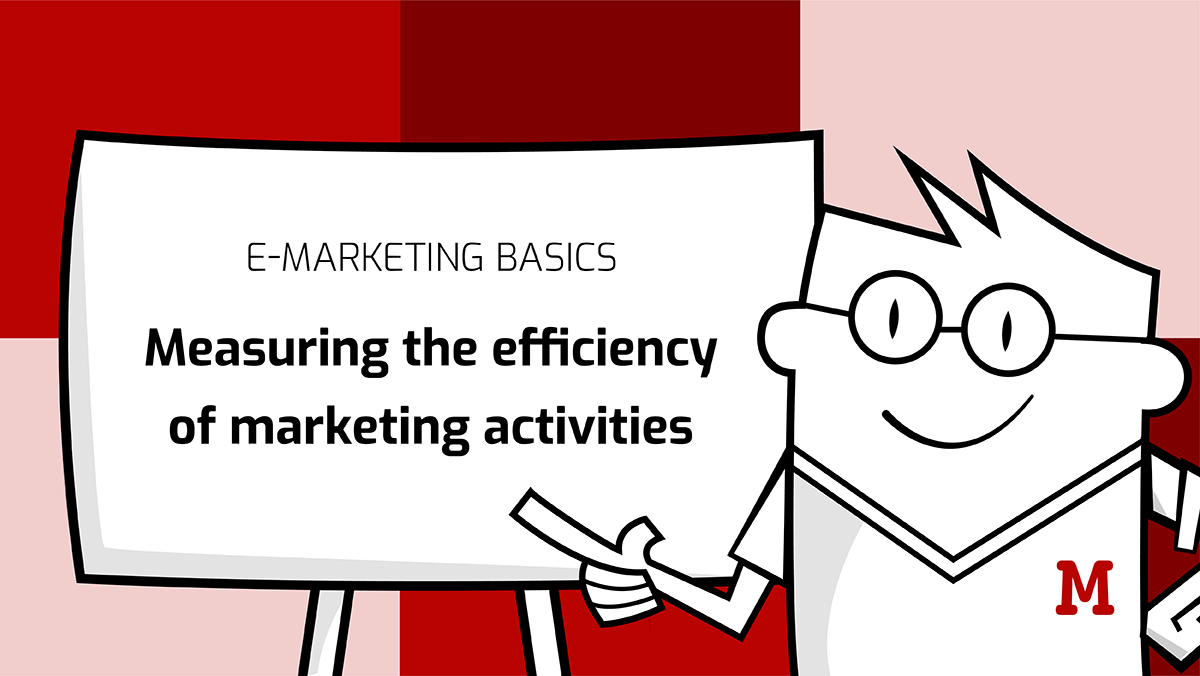Measuring the efficiency of marketing activities

When you decide to run a marketing campaign, you surely expect specific results. But how can you assess whether the given campaign achieved its goal? How can you measure the efficiency of your marketing activities? That, of course, depends on what you’re actually doing. Let’s have a look at some common options.
Of course, we can’t squeeze all possible marketing activities into one short article; it all depends on your goals. If you’re after recognizability, you will count impressions and views. If you’re after sales, you will count conversions and orders. In this post, we will show you some of the basic and universal forms of marketing analytics so that you know if it works, whatever you’re doing marketing-wise.
Start with analytics software
Some marketing activities are easy to track and calculate. Social media posts are good examples. Every social media platform tells you how many people viewed, clicked, or liked a given post. However, usually, you’ll need some sort of marketing analytics software.
Here, Google Analytics is a good starting point. It’s a free tool that enables you to track all the relevant data concerning your website and people visiting it. Thanks to Google Analytics, you can discover:
- How you get website traffic (from what sources)
- What are the characteristics of your target audience
- What visitors actually do on your website, how they interact with it (what posts and subpages they view, how much time they spend on your web page, etc.)
- What path your visitors usually take when they visit your site (from entering to exiting)
- What are your most effective landing pages
- How your website is performing (e.g., when it comes to load times)
- What keywords and key phrases people use to find your website
- How many sessions/unique users your website gets every month and much more
Image source: https://datastudio.google.com/reporting/e07ba956-b3ae-4f42-a69f-9a30e4023632/page/nXDGB
All you have to do to start using Google Analytics is integrate this platform with your website. You do that by pasting a short code to your website’s code. You can find instructions on how to do that here.
In fact, every professional marketing tool comes with an analytics module. For instance, Mailchimp, a tool for email marketing, helps you track the effectiveness of your emails and newsletters (open rate and click rate, but this tool offers monitoring of the engagement, growth, and revenue of your campaigns across different channels).
Measuring the efficiency of ads
In our article about billing models, we told you that there are five common billing models when it comes to online ads. Naturally, when the settlement is in the CPC (cost per click) model, you pay for clicks and measure ad effectiveness by how many people clicked it, and so on. Of course, that’s not the only thing you can do. You can also measure views and conversions (depending on your goals). Obviously, to run online ads, you need a place to run them. Today, most marketers focus on two major sources – Google and Facebook. Why? Because these two platforms give you access to the vast majority of internet users worldwide.
Each of these platforms has its own analytics dashboard. So, when you set a campaign on Facebook, you can go to Facebook Business Manager (currently Meta Business Suite) and go to the “insights” section, where you can see your activity (number of posts/stories), your results (page/ad reach), and the growth of your audience. Here’s an exemplary report from the results section:
Other platforms, including Google, Instagram, LinkedIn, Twitter etc., work exactly the same. You order ads, and you get access to an analytics dashboard where you have all the relevant data in one place. Of course, you can cross-reference these results with what you get from Google Analytics to get a more comprehensive view.
Measuring SEO
SEO is a long-term marketing strategy. You probably won’t see spectacular results within several days or even weeks. But the results SEO produces are also long-term. When you get to the first page in the SERP, it can be a valuable source of new business for many months to come. The efficiency of SEO can be measured by how well your website matches Google’s requirements. In practice, this means:
- What’s your website authority: This index describes your website’s relevance for a specific subject area or industry. It’s calculated from 0 to 100, and the higher the number, the more likely it is for your website to rank high on Google.
- How many backlinks you have: In other words, how many websites link to your website. The more backlinks (of high quality), the better.
- Is your website fast to load and mobile-friendly: These are two prerequisites for your website’s good visibility in Google. According to recent Google requirements (knowns as Core Web Vitals), your website should load in under 2.5 seconds.
- What’s your website’s position in the SERP: That’s the most obvious metric; the higher you get in Google, the more effective are your SEO efforts.
You cannot measure the efficiency of your SEO-related activities on your own. You need a specific tool, and there are a few of them:
- Ahrefs
- Senuto
- Semrush
- Ubersuggest
These tools provide you with relevant data concerning your website’s performance, backlinks, DA (Domain Authority), and other elements necessary to asses how efficient your SEO is.
Measuring content marketing
That’s probably the trickiest part. Perhaps you’ve heard that content marketing is not a direct sales tool. And that’s true; the role of content marketing is to facilitate sales by:
- Providing current and potential customers with the information and advice they need
- Educate the market
- Showing benefits of your offer/service/product
- Explaining how to make the most of what you offer
Content marketing is also a vast field, as it comprises blog posts, guest posts, newsletters, social media posts, press releases, landing pages, and even ads. Each of these forms is measured in a different way. Many people believe blog posts are not effective – you can’t measure their efficiency nor assess how they help in sales. That’s not entirely true. For starters, thanks to Google Analytics, you can see which posts are interesting for your target audience (because they are clicked and viewed). Secondly, you can run ad campaigns and direct them to specific blog posts to boost readability. And thirdly, when you write posts tailored to your sales needs, you can see how they correlate with sales (e.g., how many people click links/CTA buttons located in a given blog post).
CONTENT TAILORED TO SALES
In our article about sales funnels, we told you that there are three major stages of every sales process:
- TOFU – top of the funnel
- MOFU – middle of the funnel
- BOFU – bottom of the funnel
You can create posts and articles tailored towards the needs of each of these stages. Let’s use a quick example. Suppose you offer SEO services, and you want to educate and encourage clients to use your services. What can you do? You can publish texts that are for:
1. TOFU: Is SEO a worthy marketing strategy? How can you get customers on the Internet? What is positioning?
2. MOFU: SEO vs. SEM. Why is my website not visible on Google? How can I adapt my website to mobile devices? How to speed up page loading.
3. BOFU: SEO – on your own or with an agency? How to choose an SEO agency. How to make SEO effective. How long does it take to boost a website’s position on Google?
This way, your content is in full alignment with your sales efforts. And that’s, in essence, the role of content marketing. It’s like a wingman to your sales department.
Measure your marketing campaigns with iPresso
Here at iPresso, we fully understand the value of marketing analytics. That’s why our platform comes with extensive analytics features to measure the effectiveness of your marketing automation campaigns. And, what’s very useful, you can integrate iPresso with Google Analytics to get a more comprehensive insight into your marketing. Find out more about our analytics and start your free trial today!



